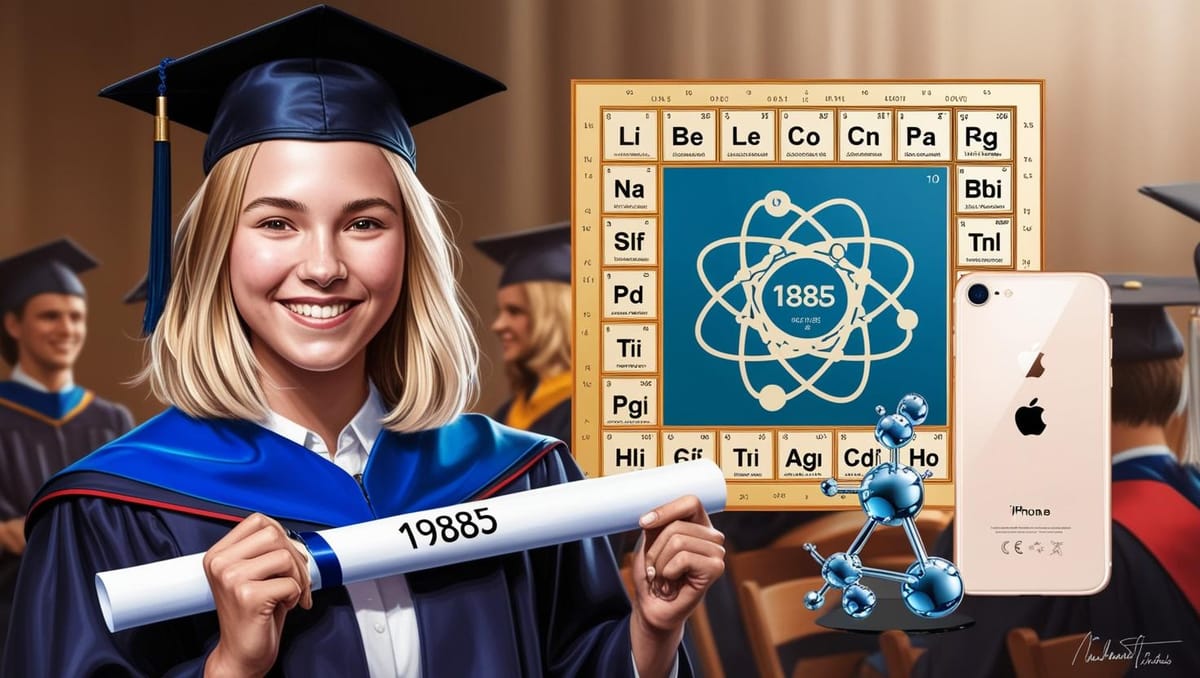
By Elke Porter | WBN News Vancouver | May 7, 2025
Ah, the 1980s—a time of epic hair, neon fashion, and Gen-X'ers graduating into a world that had most of its scientific ducks neatly in a row (or so it seemed). Fast forward to 2025, and those ducks have morphed into some kind of high-tech, quantum-computing, subatomic flock that ostensibly requires a Ph.D. to comprehend.
If the periodic table was a concert poster for New Wave bands back then, today it's a sprawling music festival headlined by an ever-expanding lineup of elements. Since 1985, scientists have discovered or officially recognized several new elements, expanding the periodic table beyond what any '80s kid memorized in chemistry class. Here are three of the most notable additions:
1. Darmstadtium (Ds) – Element 110
Discovered in 1994 by German scientists at the GSI Helmholtz Centre, this synthetic element is named after Darmstadt, the city where it was first created. It’s so unstable that it vanishes in milliseconds—kind of like your patience when someone says, "Wait, let me check the map," during a road trip.
2. Oganesson (Og) – Element 118
The heaviest element on the periodic table (for now), Oganesson was officially named in 2016 after Russian physicist Yuri Oganessian. It’s a noble gas… except it probably doesn’t act very noble because it decays almost instantly. Think of it as the "here for a good time, not a long time" element.
3. Livermorium (Lv) – Element 116
Named after the Lawrence Livermore National Laboratory in California (where it was created in collaboration with Russian scientists), Livermorium is another short-lived synthetic element. It’s so rare that if you ever stumble across it in the wild, you should probably buy a lottery ticket immediately.
These elements don’t exactly show up in nature (or stay around long enough to be useful), but their discovery pushes the boundaries of chemistry—proving that science didn’t just stop after the invention of the Rubik’s Cube and MTV.
Quantum Chips & Qubits
Let’s talk about quantum chips and qubits. Say goodbye to the trusty silicon chip—quantum chips leverage the mysterious interactions of particles that can be in two states at once! It's as if Schrödinger's cat is simultaneously alive, dead, and planning its weekend getaway. And qubits are the rockstars of this realm, juggling information in a dance that defies the binary traditions of the digital age. Sure, it's thrilling, but it also gives “keeping up with the times” a whole new, hyper-dimensional meaning.
Photos and Superfluid Helium
Photons have leapt out of physics textbooks and into daily life—they’re beaming data through fiber optics faster than your teenage kid’s sarcasm. And speaking of futuristic tech, scientists are synthesizing crystals in record time, not in a Dravidian temple but in those mystical quantum contraptions. Meanwhile, the humble helium we once inhaled for a giggle now performs gravity-defying tricks, as it climbs the walls of a container as a superfluid.
Subatomic Scientific Tools -‘Regular Tiny’ Wasn’t Small Enough
Microscopes now practically whisper things like “You can look, but don’t breathe” as they unveil the subatomic realm with freakish precision. Meanwhile, quantum tech—being the high-maintenance superstar it is—refuses to work unless coddled in a near-perfect vacuum, chilled to near-absolute zero, and shielded from cosmic side-eye. Forget Schrödinger’s cat; this is more like Schrödinger’s pop star—one wrong vibration and the whole show collapses. And yet, despite its diva tendencies, we keep building tools tinier than the patience required to untangle a vintage cassette tape… or the odds of assembling IKEA furniture without swearing.
Follow the science
Of course, the mask instructions during the pandemic left everyone in a state of bewilderment—like trying to follow a game of Calvinball where the rules changed every five minutes. "Follow the science!" they said… right before flipping the script more often than a Netflix algorithm. Wear it! Don’t wear it! Cloth is fine—wait, no, make it three layers... By the end, we were all half-convinced that the real scientific breakthrough would be quantum-entangling the guidance so it could be right, wrong, and irrelevant all at once.
Gravity Waves & Cosmic Ripples
Remember when gravity was just the thing that made your parachute pants sag? Well, hold onto your leg warmers, because in 2015, scientists detected gravitational waves—ripples in spacetime caused by cosmic cataclysms like colliding black holes. It’s as if the universe itself dropped a mic, and we finally heard the echo. Einstein predicted these waves a century ago, but proving their existence took until the era of smartphones and TikTok dances. Now, instead of just worrying about wrinkles in your clothes, you can stress about wrinkles in the fabric of reality.
CRISPR: The Genetic Editing Tool So Precise That it Makes Scissors Look Like Stone Age Tech
Back in the '80s, genetic engineering meant splicing DNA with all the precision of a kid with safety scissors and a glue stick. Enter CRISPR—a gene-editing tool so precise it makes a Swiss watch look like a sundial. Scientists can now tweak DNA like a Word doc, snipping out disease-causing mutations or, theoretically, giving your future goldfish a mustache (for science, obviously). Of course, with great power comes great responsibility, and also the occasional existential crisis—like wondering if your next cold could be cured… or if someone’s biohacking a glow-in-the-dark cat. Again.
Quantum supremacy sounds like something a sci-fi villain would announce before enslaving humanity—and yet, here we are. Google Quantum AI just dropped Willow, their latest quantum chip, which flexes its computational muscles by solving in five minutes a problem that would take today’s fastest supercomputers roughly 10 septillion years (aka "longer than the universe has existed"). Even better? It reduces errors as it scales up—basically getting more stable the bigger it grows, like a Jenga tower that somehow improves the more you yank blocks out. Sure, it’s a breakthrough that could revolutionize AI, medicine, and cryptography… but let’s be real, it’s also the kind of tech that makes you side-eye your smart speaker and whisper, "You’re not planning anything, are you?"
Science Rollercoaster Whiplash
From helium party tricks to quantum superposition, Gen-X'ers revisiting science today might feel like they're strapped into a rollercoaster designed by Dr. Emmett Brown, oscillating between bewilderment and awe at the speed of light. And this is before learning about the probabilities in cutting-edge quantum physics.
Yet, diving back into science is less about understanding everything overnight and more about embracing this ever-shifting landscape with the same curiosity that marked the 1980s—a digital mixtape of wonder, excitement, and a touch of nostalgic humor.
#Science Revisited #Quantum Computing #Gen X Science #Future Tech #Quantum Physics #Nanotechnology #Science Innovation #Tech Trends 2025 #WBN News Vancouver #Elke Porter
Connect with Elke at Westcoast German Media or on LinkedIn: Elke Porter or contact her on WhatsApp: +1 604 828 8788


